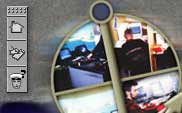

Courses for Deck Officers
RADAR OBSERVATION AND PLOTTING. AUTOMATIC RADAR PLOTTING AIDS (ARPA)
MANEUVERING AND SHIP-HANDLING
ICE NAVIGATIONMakarov Training Centre established professional training for deck officers, ship engineers, pilots and ship operators on ice navigation in compliance with IMO guidelines.
The course consists of theory classes combined with practical exercises using the combined full-mission Bridge-and-Engine Simulator with unique Ice Navigation Model under supervision of experienced instructors, ice breaker's masters and ice pilots sharing their ice expertise with trainees.
Theory
- Safe working practices in cold climate
- Types of ice and Ice charts reading
- Manoeuvering in ice waters
- Principles of ice breakers operations
- Convoy formation
- Freeing from ice
- New trends in ice ship constructions
Exercises
- Bridge watch keeping during unassisted passage of tanker in ice
- Entering an ice area
- Passage with ice breaker assistance. Convoy passage and ice passage in broken ice, maneuvering in ice channel, rudder and engine operations
- Safe port operations procedures in low temperatures, mooring/unmooring, working with tugs in ice conditions
- Both daytime and night time navigation.
Currently we are offering two ice navigation programmes:
- Compact course for officers with ice navigation experience for calling at the ports of Primorsk and Vysotsk (Gulf of Finland) during winter season
- Advanced course for officers with no ice experience.
Ice Navigation competence assessment on completion the courses is provided using PC-based "Delta-Ice" testing toolkit as well as TEAS simulator utility.
Compact Course duration: 2 days
Advanced Course duration: one week
RADAR OBSERVATION AND PLOTTING.
AUTOMATIC RADAR PLOTTING AIDS (ARPA)Training is provided with the use of simulator comprising 6 active ships and imitating up to 50 targets, the coastline with all navigational features including RACONS. The behavior of the simulated ships is very closely imitated. Such factors as: influence of shallow waters, currents yawing, state of the sea and atmospheric conditions are taken into consideration. Imitation of navigation is very close to real conditions, which can be encountered by the students.
The Makarov Training Centre is licensed by the Russian Federation Marine Administration for both primary training and updating (i.e. renewal of the certificate on expiration of the allowed 5 year period).
Training programmes are approved by the Merchant Shipping Service of the Ministry of Sea Transport and lectured by instructors having great practical experience both as deep-sea Masters and Chief Officers and lecturers. The use of the most up-to-date ARPA meeting the latest IMO requirements (Resolutions A.477 and A.823) ensures compliance with the world standards. Training courses in radar observation and plotting and automatic radar plotting aids can be provided simultaneously within a very short period - 1 week.
Duration of courses:
- radar plotting and observation or automatic radar plotting aids certificates - 1 week
- combined course ARPA / Radar plotting - 1 week.
Training is effected in compliance with the STCW 78/95 Convention and N1 Regulation of Department of the Sea Transport of the Russian Federation. It is based on IMO Model courses (1.22, 7.01, 7.03) and is intended for Masters, navigators and pilots.
The course is aimed at training in ship-handling primarily in congested waters and difficult weather conditions, mooring operations, maneuvering at slow speed, passing through channels and fairways taking into account the influence of external factors etc.
Training is provided with the use of the most modern simulator of the navigating bridge approved by the Department of the Sea Transport of the Ministry of Transport of the Russian Federation. The simulator is licensed by the UK's Marine Safety Management (MCA).
The programme of the course includes:
Course duration: 1 week
- IMO characteristics of the maneuvering elements
- Forces influencing the ship
- Sailing through channels and narrows in difficult weather conditions (winds, currents)
- Passing maneuvering
- Mooring operations in ports and on high seas
- Anchoring and weighing achor
- Use of thrusters
- Use of tugs, etc.